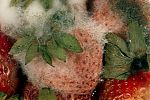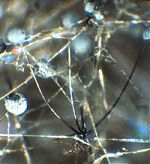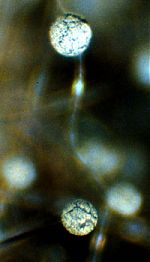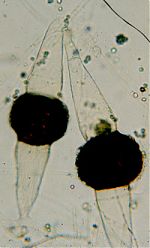Rhizopus
RHIZOPUS Ehrenberg, 1820 (Nova Acta Phys.- Med. Acad. Caes. Leop. Carol. Nat. Cur. 10: 198); 13 spp. + 8 var. (Schipper, 1984, and Schipper and Stalpers, 1984—monograph).
= Ascophora Tode: Fr., 1832 Syst. Mycol. 3(2):309; fide Kirk, 1986), nomen concerv., Art. 13.1(d) of the ICBN; Greuter et al., 2000 (see Korf, 1982, 1983).
= Amylomyces Calmette, 1892 (Ann. Inst. Pasteur 6:611; fide Ellis, 1985; see also Ellis et al., 1976).
Rhizopus (Schipper 1984; Schipper and Stalpers 1984) is characterized by the formation of apophysate sporangia with an evanescent wall that reveals a dry, grayish, spore-mass with surface cracks at maturity. When the fungus is mounted in liquid the relatively large columella collapses over the apex of the sporangiophore. Stolons and rhizoids are produced and the sporangiophores only arise opposite the rhizoids. Zygospores form a pigmented, rough zygosporangial wall, and opposed, more or less equal, nonappendaged suspensors.
Type species: R. stolonifer
Species of Rhizopus:
R. azygosporus G.-F. Yuan & S.-C. Jong, 1984 (Mycotaxon 20:398).
R. caespitosus Schipper & Samson, 1994 (Mycotaxon 50:482).
R. circinans van Tieghem, 1878 (Ann. Sci. Nat., Bot., Sér. VI, 4:369).
R. echinatus van Tieghem, 1878 (Ann. Sci. Nat., Bot., Sér. VI, 4:370).
R. equinuus Costantin & Lucet, 1903 (Bull. Soc. Mycol. France 19:202).
R. homothallicus Hesseltine & Ellis, 1961 (Mycologia 53:419).
R. megasporus Boedijn, 1958 (Sydowia 12:328).
R. microsporus van Tiegh. var. chinensis (Saito) Schipper & Stalpers, 1984 (Studies Mycol. 25:31)
R. microsporus var. microsporus van Tieghem, 1875 (Ann. Sci. Nat. Bot., Sér. 6, 1:83)
R. microsporus van Tiegh. var. oligosporus (Saito) Schipper & Stalpers, 1984 (Studies Mycol. 25:31).
R. microsporus var. tuberosus R.-y. Zheng & G.-q. Chen, 1998 (Mycotaxon 69:183)
R. minimus van Tieghem, 1875 (Ann. Sci. Nat., Bot., Sér. VI, 1:84).
R. oryzae Went. & Prinsen Geerl., 1895 (Verh. Kon. Akad. Wet., Sect. 2, 4:16).
R. schipperae Weitzman, McGough, Rinaldi & Della-Lata, 1996 (Mycotaxon 59:220) .
R. sexualis var. americanus Hesseltine & Ellis, 1961 (Mycologia 53:424).
R. sexualis (Smith) Callen var. sexualis, 1940 (Ann. Bot., n.s., 4:793).
R. stolonifer var. stolonifer (Ehrenberg: Fr.) Vuillemin, 1902 (Rev. Mycol. 24: 54).
R. stolonifer var. lyococcos (Ehhrenb.:Fr.) Stalpers & Schipper, 1984 (Studies Mycol. 25: 10).
Schipper (1984), and Schipper and Stalpers (1984) included 5 spp. and 8 varieties in their treatment of the genus. Important characteristics are growth temperature (growth or no growth at 36 C and 45 C) and the length of the sporangiophores (above or below 1 mm). Size of the sporangia and sporangiospores and the ornamentation of the latter structures are also key characters. One species, R. oryzae, has 30 synonyms that are species that were mostly described from food or alcoholic beverages made in China, Indonesia, and Japan (Hesseltine 1965). Three additional species R. azygosporus (Yuan and Jong 1984), R. caespitosus (Schipper and Samson 1994), R. schipperae (Weitzman et al. 1996)] and one variety R. microsporus var. tuberosus (Zheng and Chen 1998)] have been described since the monograph was published (Schipper 1984; Schipper and Stalpers 1984). Amylomyces is considered a synonym of Rhizopus (Ellis, 1985; Ellis et al., 1976).
Rhizopus spp. are important as agents of food spoilage, mucormycosis, food fermentations (especially in Asia), and they may occur as saprobes on plant debris, soil, and dung, or as air contaminants.
Bibliography
Ellis, J.J. 1985. Species and varieties in the Rhizopus arrhizus-Rhizopus oryzae group as indicated by their DNA complementarity. Mycologia 77:243-247.
Ellis, J.J., L.J. Rhodes, and C.W. Hesseltine. 1976. The genus Amylomyces. Mycologia 68:131-143.
Greuter, W., J. McNeill, F.M. Barrie, H.M. Burdet, V. Demoulin, T.S. Filgueiras, D.H. Nicolson, P.C. Silva, J.E. Skog, P. Trehane, N.J. Turland, and D.H. Hawksworth (Eds.). 2000. International code of botanical nomenclature ( St. Louis code ). Reg. veget. 138:1-474.
Hesseltine, C.W. 1965. A millennium of fungi, food, and fermentation. Mycologia 57:149-197.
Kirk, P.M. 1986. (815) Proposal to conserve Mucor Fresenius over Mucor Micheli ex L. and (816) Proposal to conserve Rhizopus Ehrenberg over Ascophora Tode (Fungi) with notes on the nomenclature and taxonomy of Mucor, Ascophora, Hydrophora and Rhizopus. Taxon 35:371-377.
Korf, R. P. 1982. Citation of authors’ names and the typification of names of fungal taxa published between 1753 and 1832 under the changes in the Code of Nomenclature enacted in 1981. Mycologia 74:250-255.
Korf, R.P. 1983. Sanctioned epithets, sanctioned names, and cardinal principles in “: Pers.” and “: Fr.” citations. Mycotaxon 16:341-352.
Schipper, M.A.A. 1984. A revision of the genus Rhizopus. I. The Rhizopus stolonifer-group and Rhizopus oryzae. Studies Mycol. (Baarn) 25:1-19.
Schipper, M.A.A., and R.A. Samson. 1994. Miscellaneous notes on Mucoraceae, Mycotaxon 50:475-491.
Schipper, M.A.A., and Stalpers, J.A. 1984. A revision of the genus Rhizopus. II. The Rhizopus microsporus-group. Studies Mycol. (Baarn) 25:20-34.
Weitzman, I., D.A. McGough, M.G. Rinaldi, and P. Della-Lata. 1996. Rhizopus schipperae, sp. nov., a new agent of zygomycosis. Mycotaxon 59:217-225.
Yuan, G.-F., and S.-C. Jong. 1984. A new obligate azygosporic species of Rhizopus. Mycotaxon 20:397-400.
Zheng, R.-y., and G.-q. Chen. 1998. Rhizopus microsporus var. tuberosus var. nov. Mycotaxon 69:181-186.
Updated Mar 12, 2005




